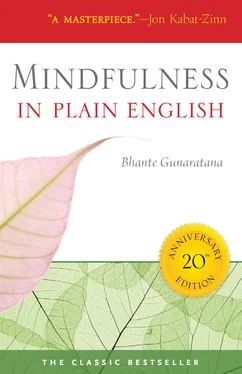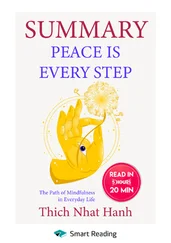Henepola Gunaratana - Mindfulness in Plain English
Здесь есть возможность читать онлайн «Henepola Gunaratana - Mindfulness in Plain English» весь текст электронной книги совершенно бесплатно (целиком полную версию без сокращений). В некоторых случаях можно слушать аудио, скачать через торрент в формате fb2 и присутствует краткое содержание. Жанр: Самосовершенствование, на английском языке. Описание произведения, (предисловие) а так же отзывы посетителей доступны на портале библиотеки ЛибКат.
- Название:Mindfulness in Plain English
- Автор:
- Жанр:
- Год:неизвестен
- ISBN:нет данных
- Рейтинг книги:3 / 5. Голосов: 1
-
Избранное:Добавить в избранное
- Отзывы:
-
Ваша оценка:
- 60
- 1
- 2
- 3
- 4
- 5
Mindfulness in Plain English: краткое содержание, описание и аннотация
Предлагаем к чтению аннотацию, описание, краткое содержание или предисловие (зависит от того, что написал сам автор книги «Mindfulness in Plain English»). Если вы не нашли необходимую информацию о книге — напишите в комментариях, мы постараемся отыскать её.
Mindfulness in Plain English — читать онлайн бесплатно полную книгу (весь текст) целиком
Ниже представлен текст книги, разбитый по страницам. Система сохранения места последней прочитанной страницы, позволяет с удобством читать онлайн бесплатно книгу «Mindfulness in Plain English», без необходимости каждый раз заново искать на чём Вы остановились. Поставьте закладку, и сможете в любой момент перейти на страницу, на которой закончили чтение.
Интервал:
Закладка:
Mindfulness in Plain English
About the Author
Venerable Henepola Gunaratana was ordained at the age of 12 as a Buddhist monk at a small temple in Malandeniya Village in Kurunegala District in Sri Lanka. His preceptor was Venerable Kiribatkumbure Sonuttara Mahathera. At the age of 20 he was given higher ordination in Kandy in 1947. He received his education from Vidyalankara College and Buddhist Missionary College in Colombo. Subsequently he traveled to India for five years of missionary work for the Mahabodhi Society, serving the Harijana (Untouchable) people in Sanchi, Delhi, and Bombay. Later he spent ten years as a missionary in Malaysia, serving as religious advisor to the Sasana Abhivurdhiwardhana Society, Buddhist Missionary Society and the Buddhist Youth Federation of Malaysia. He has been a teacher in Kishon Dial School and Temple Road Girls’ School and Principal of the Buddhist Institute of Kuala Lumppur.
At the invitation of the Sasana Sevaka Society, Venerable Gunaratana came to the United States in 1968 to serve as Hon. General Secretary of the Buddhist Vihara Society of Washington, D.C. In 1980 he was appointed President of the Society. During his years at the Vihara, he has taught courses in Buddhism, conducted meditation retreats, and lectured widely throughout the United States, Canada, Europe, Australia and New Zealand.
He has also pursued his scholarly interests by earning a B.A., and M.A., and a Ph.D. in Philosophy from the American University. He taught courses in Buddhism at the American University, Georgetown University and University of Maryland. His books and articles have been published in Malaysia, India, Sri Lanka and the United States.
Since 1973 he has been buddhist chaplin at The American University counseling students interested in Buddhism and Buddhist meditation. He is now president of the Bhavana Society in West Virginia in the Shenandoah Valley, about 100 miles from Washington, D.C. teaching meditation and conducting meditation retreats.
Preface
In my experience I found that the most effective way to express something in order to make others understand is to use the simplest language. Also I learned from teaching that the more rigid the language the less effective it is. People to not respond to very stern and rigid language especially when we try to teach something which normally people don’t engage in during their daily life. Meditation appears to them as something that they cannot always do. As more people turn to meditation, they need more simplified instructions so they can practice by themselves without a teacher around. This book is the result of requests made by many meditators who need a very simple book written in ordinary colloquial language.
In preparing this book I have been helped by many of my friends. I am deeply grateful to all of them. Especially I would like to express my deepest appreciation and sincere gratitude to John Patticord, Daniel J. Olmsted, Matthew Flickstein, Carol Flickstein, Patrick Hamilton, Genny Hamilton, Bill Mayne, Bhikkhu Dang Pham Jotika and Bhikkhu Sona for their most valuable suggestions, comments and criticisms of numerous points in preparing this book. Also thanks to Reverend Sister Sama and Chris O’Keefe for their support in production efforts.
H. Gunaratana Mahathera
Bhavana Society
Rt. 1 Box 218-3
High View, WV 26808
December 7, 1990
Introduction
American Buddhism
The subject of this book is Vipassana meditation practice. Repeat, practice. This is a meditation manual, a nuts-and-bolts, step-by-step guide to Insight meditation. It is meant to be practical. It is meant for use.
There are already many comprehensive books on Buddhism as a philosophy, and on the theoretical aspects of Buddhist meditation. If you are interested in that material we urge you to read those books. Many of them are excellent. This book is a ‘How to’. It is written for those who actually want to meditate and especially for those who want to start now. There are very few qualified teachers of the Buddhist style of meditation in the United States of America. It is our intention to give you the basic data you need to get off to a flying start. Only those who follow the instructions given here can say whether we have succeeded or failed. Only those who actually meditate regularly and diligently can judge our effort. No book can possibly cover every problem that a meditator may run into. You will need to meet a qualified teacher eventually. In the mean time, however, these are the basic ground rules; a full understanding of these pages will take you a very long way.
There are many styles of meditation. Every major religious tradition has some sort of procedure which they call meditation, and the word is often very loosely used. Please understand that this volume deals exclusively with the Vipassana style of meditation as taught and practiced in South and Southeast Asian Buddhism. It is often translated as Insight meditation, since the purpose of this system is to give the meditator insight into the nature of reality and accurate understanding of how everything works.
Buddhism as a whole is quite different from the theological religions with which Westerners are most familiar. It is a direct entrance to a spiritual or divine realm without addressing deities or other ‘agents’. Its flavor is intensely clinical, much more akin to what we would call psychology than to what we would usually call religion. It is an ever-ongoing investigation of reality, a microscopic examination of the very process of perception. Its intention is to pick apart the screen of lies and delusions through which we normally view the world, and thus to reveal the face of ultimate reality. Vipassana meditation is an ancient and elegant technique for doing just that.
Theravada Buddhism presents us with an effective system for exploring the deeper levels of the mind, down to the very root of consciousness itself. It also offers a considerable system of reverence and rituals in which those techniques are contained. This beautiful tradition is the natural result of its 2,500-year development within the highly traditional cultures of South and Southeast Asia.
In this volume, we will make every effort to separate the ornamental and the fundamental and to present only the naked plain truth itself. Those readers who are of a ritual bent may investigate the Theravada practice in other books, and will find there a vast wealth of customs and ceremony, a rich tradition full of beauty and significance. Those of a more clinical bent may use just the techniques themselves, applying them within whichever philosophical and emotional context they wish. The practice is the thing.
The distinction between Vipassana meditation and other styles of meditation is crucial and needs to be fully understood. Buddhism addresses two major types of meditation. They are different mental skills, modes of functioning or qualities of consciousness. In Pali, the original language of Theravada literature, they are called ‘Vipassana’ and ‘Samatha’.
‘Vipassana’ can be translated as ‘insight’, a clear awareness of exactly what is happening as it happens. ‘Samatha’ can be translated as ‘concentration’ or ‘tranquility’. It is a state in which the mind is brought to rest, focused only on one item and not allowed to wander. When this is done, a deep calm pervades body and mind, a state of tranquility which must be experienced to be understood. Most systems of meditation emphasize the Samatha component. The meditator focuses his mind upon some items, such as prayer, a certain type of box, a chant, a candle flame, a religious image or whatever, and excludes all other thoughts and perceptions from his consciousness. The result is a state of rapture which lasts until the meditator ends the session of sitting. It is beautiful, delightful meaningful and alluring, but only temporary. Vipassana meditation address the other component, insight.
Читать дальшеИнтервал:
Закладка:
Похожие книги на «Mindfulness in Plain English»
Представляем Вашему вниманию похожие книги на «Mindfulness in Plain English» списком для выбора. Мы отобрали схожую по названию и смыслу литературу в надежде предоставить читателям больше вариантов отыскать новые, интересные, ещё непрочитанные произведения.
Обсуждение, отзывы о книге «Mindfulness in Plain English» и просто собственные мнения читателей. Оставьте ваши комментарии, напишите, что Вы думаете о произведении, его смысле или главных героях. Укажите что конкретно понравилось, а что нет, и почему Вы так считаете.












